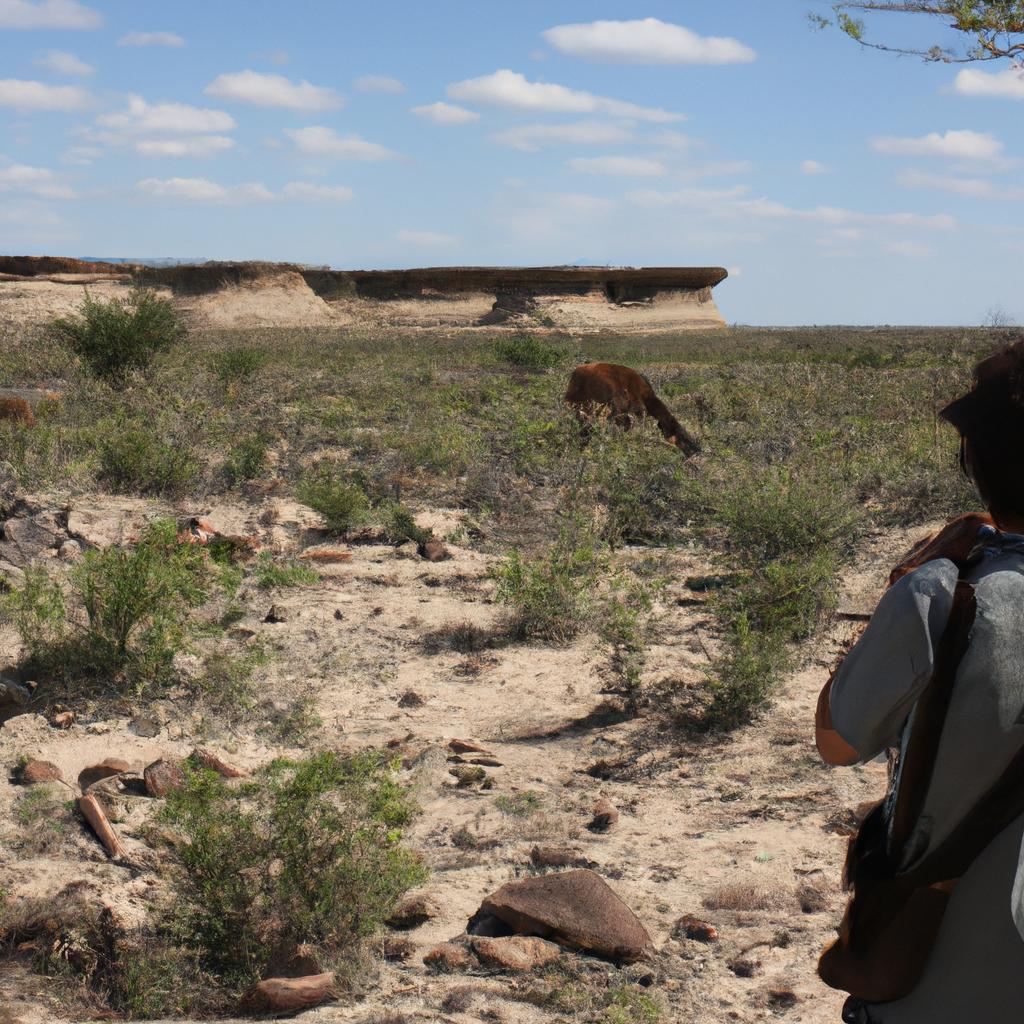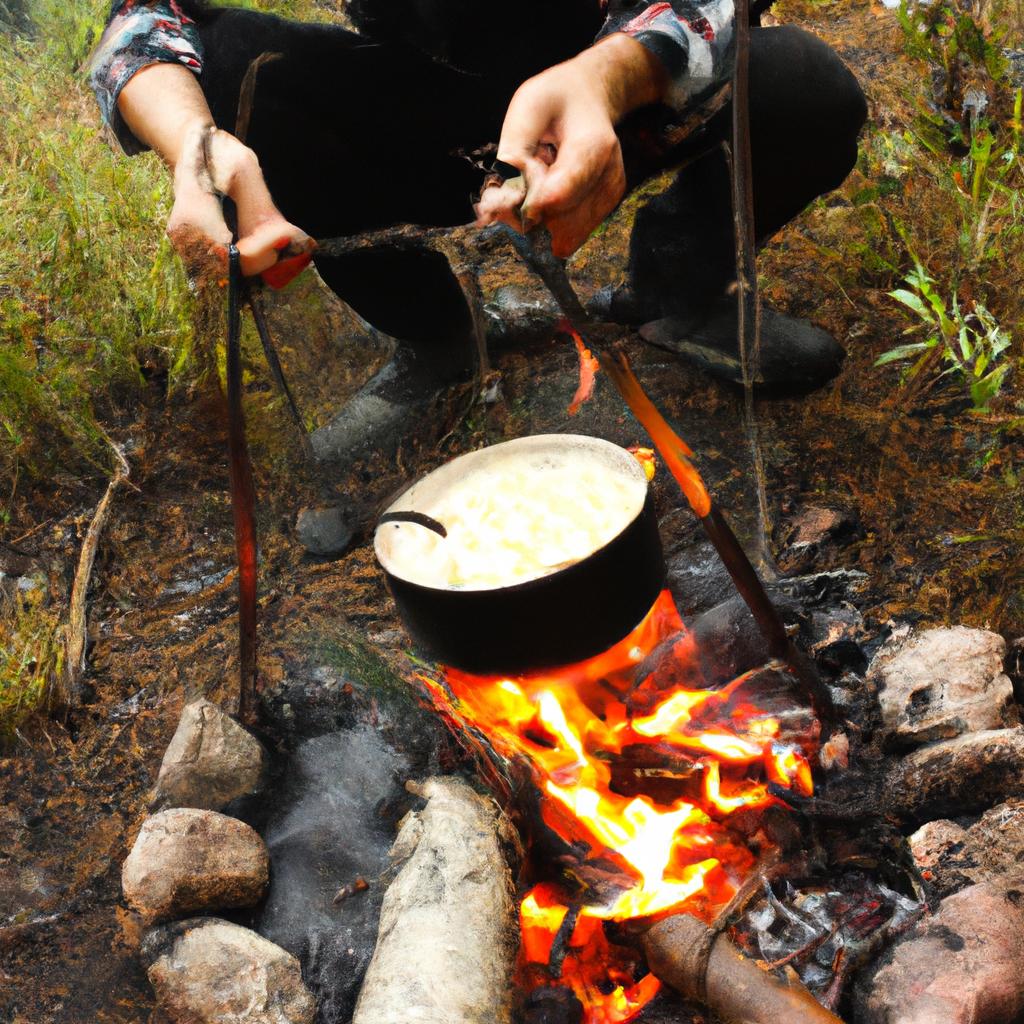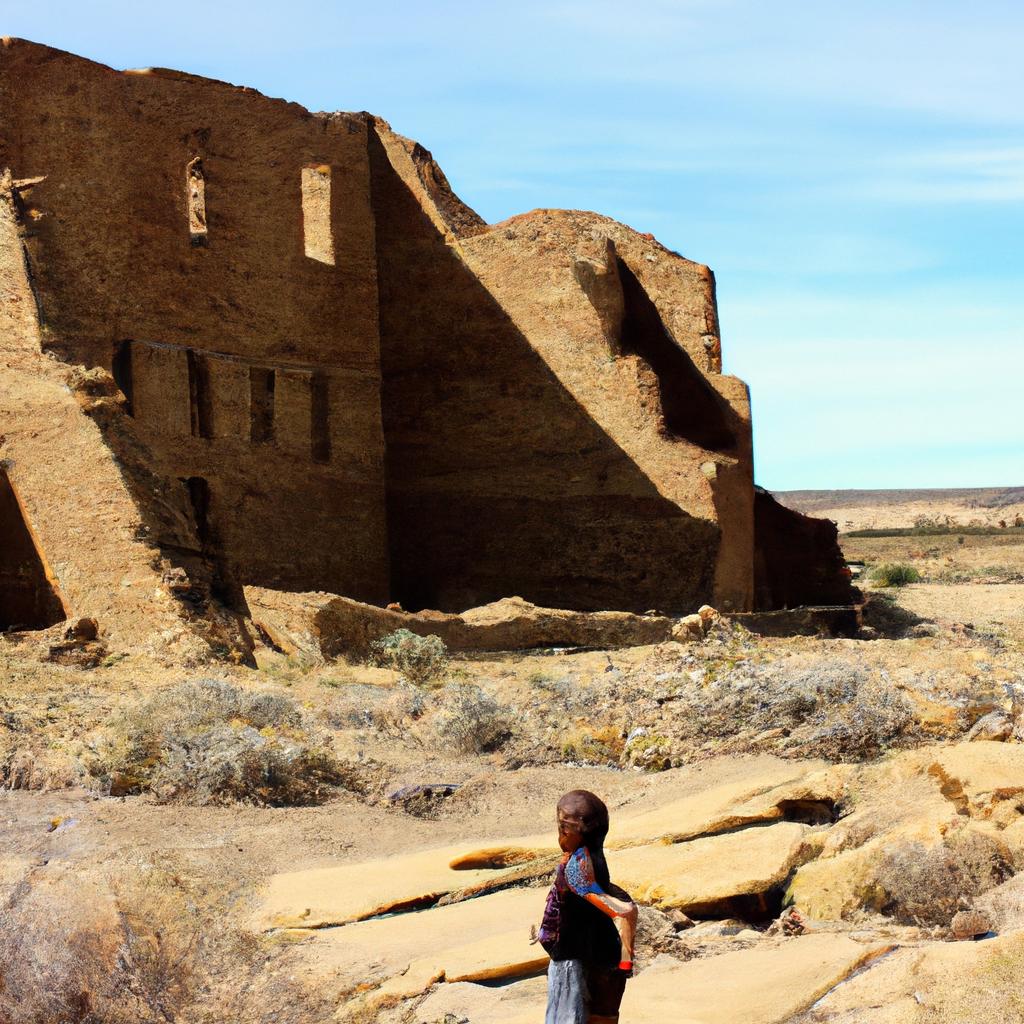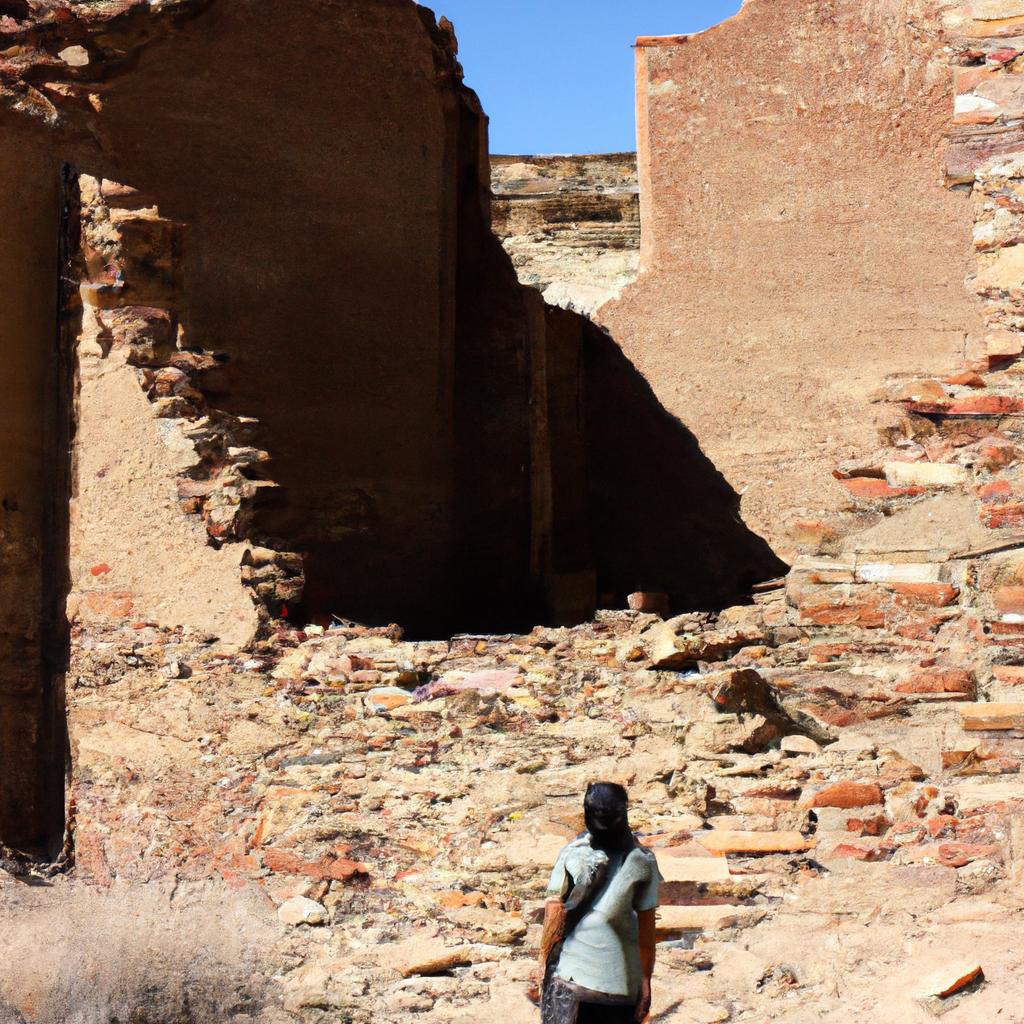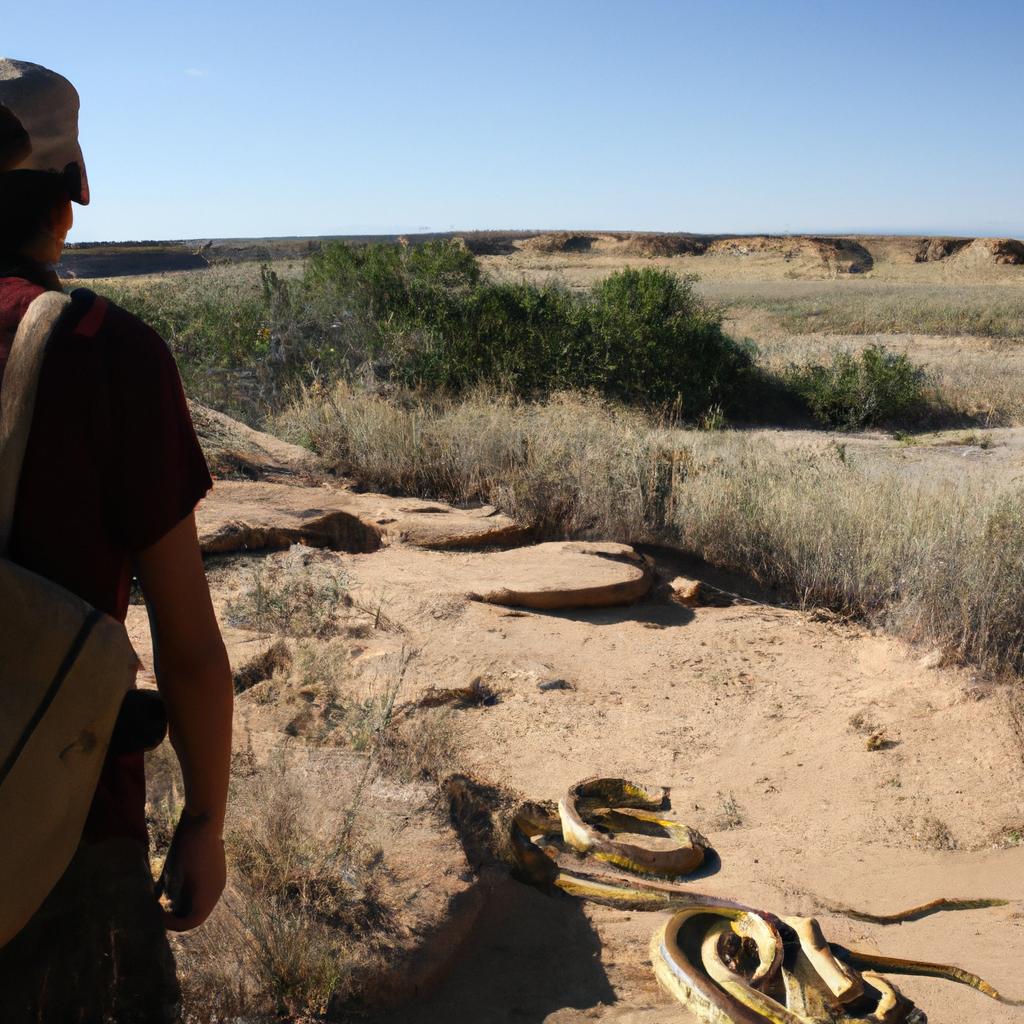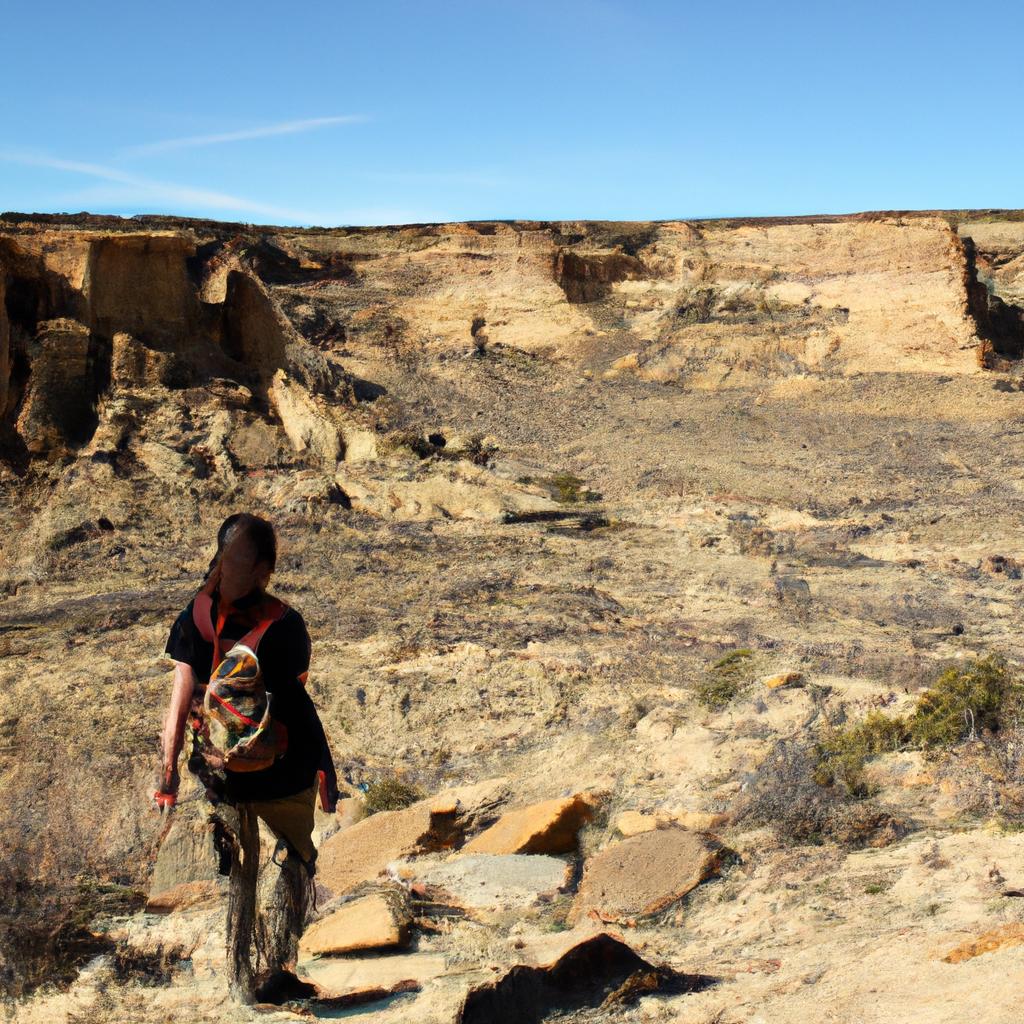The ability to spot and observe wildlife in its natural habitat is a thrilling experience for nature enthusiasts. Chaco Canyon, located in the heart of New Mexico, offers an exceptional opportunity to engage with diverse flora and fauna. For instance, imagine standing on the edge of Fajada Butte, binoculars in hand, as you catch sight of a majestic golden eagle soaring above the canyon walls. This article serves as a comprehensive camping guide for those eager to explore and maximize their chances of encountering such captivating wildlife within the unique ecosystem of Chaco Canyon.
Situated within the arid landscape of northwest New Mexico, Chaco Canyon boasts a rich biodiversity that sustains various animal species. From elusive mountain lions to graceful mule deer, this region provides ample opportunities for extraordinary wildlife encounters. Additionally, numerous bird species call Chaco Canyon home, including Gambel’s quail and black-throated sparrows. By following this camping guide, visitors can enhance their understanding of local habitats and ecosystems while enjoying a memorable wilderness experience amidst stunning archaeological ruins.
Exploring Chaco Canyon requires careful planning and adherence to guidelines set forth by park authorities. Understanding the best practices for setting up camp, minimizing impact on delicate ecosystems, and staying safe among potential wild encounters are crucial for a successful and enjoyable experience in Chaco Canyon. Here are some guidelines to follow:
-
Campsite Selection: Choose designated campsites provided by the park authorities. These sites are designed to minimize environmental impact and ensure visitor safety. Avoid camping near fragile vegetation, archaeological sites, or animal habitats.
-
Leave No Trace: Practice “Leave No Trace” principles to preserve the natural beauty of Chaco Canyon. Pack out all trash, including food scraps, and dispose of them properly. Avoid disturbing or removing any natural or cultural artifacts.
-
Wildlife Observation: When observing wildlife, maintain a respectful distance to avoid causing stress or harm to the animals. Use binoculars or telephoto lenses for a closer look instead of approaching too closely. Do not feed wildlife as it disrupts their natural behaviors.
-
Food Storage: Properly store food and scented items in bear-resistant containers or hang them from trees where allowed. This helps prevent attracting wildlife into your campsite and keeps both you and the animals safe.
-
Hiking Safety: Stay on designated trails and paths to avoid damaging fragile vegetation and archaeological sites while also minimizing encounters with potentially dangerous wildlife. Carry bear spray if hiking in areas known for bear activity and make noise periodically to alert animals of your presence.
-
Respect Quiet Hours: Be mindful of other campers by adhering to quiet hours imposed by the park authorities, usually from dusk until dawn. This allows everyone to enjoy the tranquility of Chaco Canyon’s natural surroundings undisturbed.
-
Follow Park Regulations: Familiarize yourself with all rules and regulations set forth by Chaco Culture National Historical Park before your visit. This includes permits required for certain activities such as backcountry camping or photography workshops.
By following these guidelines, visitors can help preserve the delicate ecosystems within Chaco Canyon while ensuring their own safety during encounters with wildlife. Enjoy your adventure in this unique landscape!
Best Time to Visit
When planning a wildlife spotting trip in Chaco Canyon, it is crucial to consider the best time to visit. Each season offers unique advantages and disadvantages for observing the diverse range of flora and fauna that inhabit this area.
One example illustrating the significance of timing is the case of birdwatching enthusiasts who visited Chaco Canyon during different seasons. During the spring months, they were treated to an incredible spectacle as migratory birds returned from their wintering grounds. The vibrant colors and melodious songs filled the air, creating a captivating experience for these avid observers. However, during the scorching summer months, many of these species migrate elsewhere or become less active due to extreme heat, making bird sightings more challenging.
To provide a comprehensive overview of when one can expect optimal wildlife viewing opportunities in Chaco Canyon, here is a bullet point list summarizing each season’s characteristics:
-
Spring:
- Migratory birds return
- Wildflowers bloom
- Pleasant temperatures
-
Summer:
- Heat limits animal activity
- Longer daylight hours for observation
- Opportunities for nocturnal species sightings
-
Fall:
- Foliage changes color
- Bird migration resumes (some species leave)
- Cooler temperatures compared to summer
-
Winter:
- Fewer tourists mean quieter observations
- Some animals hibernate or migrate away temporarily
- Sparse vegetation makes wildlife easier to spot
Additionally, it may be helpful to refer to the following table which presents an overview of seasonal features and conditions:
| Season | Wildlife Activity | Climate |
|---|---|---|
| Spring | High | Mild |
| Summer | Low | Hot |
| Fall | Moderate | Cool |
| Winter | Moderate/High | Cold/Mild |
In summary, choosing the right time to visit Chaco Canyon greatly impacts the wildlife spotting experience. Whether it’s the vibrant colors of spring or the tranquility of winter, each season offers its own set of advantages and limitations. Understanding these variations will help visitors plan their trips accordingly to maximize their chances of encountering a diverse range of wildlife.
Transitioning into the subsequent section about “Wildlife Diversity,” we delve deeper into the fascinating array of species that can be encountered in Chaco Canyon.
Wildlife Diversity
Best Time to Visit
When planning a wildlife spotting trip to Chaco Canyon, it is crucial to consider the optimal time for observing diverse fauna. One example of this is the case study conducted by the National Park Service, which analyzed animal sightings over a span of five years. The study found that early spring and late fall are particularly favorable seasons for encountering a wide range of wildlife species.
During these periods, animals emerge from hibernation or migrate back to their summer habitats, resulting in increased activity and visibility. To enhance your chances of spotting various creatures during your camping adventure, keep these key factors in mind:
- Weather conditions: Mild temperatures and reduced precipitation create ideal conditions for wildlife viewing.
- Food availability: Springtime brings an abundance of plant growth, attracting herbivores and subsequently carnivorous predators.
- Breeding season: Many animals choose this period to mate and raise offspring, leading to heightened activity levels.
- Migration patterns: Certain species pass through Chaco Canyon during their annual migration journeys, making it an opportune moment to spot them.
To provide a visual aid and evoke an emotional response regarding the potential diversity of wildlife present at Chaco Canyon throughout the year, refer to the following table:
| Season | Featured Species 1 | Featured Species 2 | Featured Species 3 |
|---|---|---|---|
| Early Spring | Mule Deer | Western Bluebird | Desert Cottontail |
| Late Spring | Pronghorn Antelope | Black-throated Sparrow | Kangaroo Rat |
| Summer | Greater Roadrunner | Spiny Lizard | Bobcat |
| Fall | Elk | Golden Eagle | Coyote |
As you can see from this illustrative table, each season in Chaco Canyon offers unique opportunities for wildlife spotting. Whether it’s the graceful movements of Mule Deer during early spring or the soaring majesty of Golden Eagles in the fall, visitors can expect to encounter a diverse array of species throughout the year.
Transitioning seamlessly into our next section on “Wildlife Diversity,” we will now explore some of the top animal species you might have the chance to observe during your camping trip at Chaco Canyon.
Top Animal Species
Wildlife Diversity in Chaco Canyon
As we delve deeper into the incredible world of wildlife in Chaco Canyon, it becomes evident that this ancient landscape is teeming with a remarkable array of species. Let’s explore the biodiversity found within this archaeological wonder and discover the fascinating creatures that call this place home.
One such example is the elusive black bear (Ursus americanus), which occasionally roams through the canyon. These magnificent animals have adapted to survive in diverse environments, including dense forests and arid regions like Chaco Canyon. Their presence serves as a testament to nature’s resilience and ability to adapt.
When exploring Chaco Canyon, keep an eye out for these captivating animal species:
- The swift fox (Vulpes velox), known for its agility and exceptional speed.
- The mule deer (Odocoileus hemionus), gracefully navigating through rugged terrain.
- The western diamondback rattlesnake (Crotalus atrox), camouflaged among rocks and vegetation.
- The golden eagle (Aquila chrysaetos), soaring majestically above the canyon walls.
These four examples represent just a fraction of the astonishing diversity you may encounter while camping in Chaco Canyon. To further illustrate this point, consider the following table showcasing additional animal species frequently observed in this area:
| Animal Species | Habitat | Notable Characteristics |
|---|---|---|
| Coyote | Open grasslands | Howling calls |
| Great horned owl | Forested areas | Piercing hoots |
| Collared lizard | Rocky outcroppings | Vibrant coloration |
| Mountain lion | Rugged slopes | Stealthy predators |
Immersing yourself in the rich tapestry of wildlife present here can evoke a profound sense of connection with nature. It offers an opportunity to witness firsthand the intricate interactions between different species and their environment. The diverse range of habitats within Chaco Canyon sustains a thriving ecosystem, reminding us of the delicate balance necessary for all life to thrive.
As we conclude our exploration of wildlife diversity in Chaco Canyon, our attention now turns towards another captivating aspect: bird-watching opportunities. Prepare yourself for an awe-inspiring journey through the avian wonders that grace this ancient landscape.
Transitioning seamlessly into the next section, let’s now embark on a voyage to discover the remarkable world of birds in Chaco Canyon.
Bird Watching Opportunities
Exploring the diverse wildlife of Chaco Canyon offers a unique and captivating experience for nature enthusiasts. As we delve into the fascinating world of bird watching, let’s begin by examining some exceptional opportunities that await.
Imagine standing quietly on the edge of an ancient cliff dwelling at dawn, when the first rays of sunlight illuminate the rugged landscape. Suddenly, you hear a melodious trill emanating from nearby shrubs—a Bewick’s wren! This small songbird is just one example of the avian wonders that can be spotted in Chaco Canyon.
To fully immerse yourself in this enchanting environment, consider these points:
- Seasonal Variations: Different seasons bring different species to Chaco Canyon, so plan your visit accordingly.
- Prime Viewing Spots: Identify key locations within the canyon where birds are known to congregate.
- Binoculars and Field Guides: Equip yourself with essential tools to enhance your birdwatching experience.
- Patience and Observation: Practice patience while observing birds’ behavior and take note of their distinctive characteristics.
In addition to these considerations, it is helpful to familiarize yourself with some common bird species found in Chaco Canyon. The table below provides insight into four notable varieties:
| Species | Description | Habitat |
|---|---|---|
| Great Horned Owl | Nocturnal predator renowned for its distinct hooting call | Woodlands |
| Say’s Phoebe | Small flycatcher with cinnamon-colored belly | Open areas |
| Black-throated Sparrow | Desert-dwelling sparrow recognized by its striking facial pattern | Arid landscapes |
| Western Bluebird | Vibrant blue plumage complemented by a rust-colored breast | Forest edges |
These species represent just a fraction of the rich birdlife that can be encountered while exploring Chaco Canyon. By keeping an eye out for these distinctive birds and their respective habitats, you will enhance your chances of spotting various avian wonders during your visit.
As we continue our trek through this remarkable wilderness, the subsequent section will provide valuable tips to maximize your wildlife spotting adventures in Chaco Canyon. So let us now embark on this journey with insightful guidance to delve deeper into the secrets of nature’s marvels.
[End transition sentence]
Tips for Wildlife Spotting:
Tips for Wildlife Spotting
H2: Bird Watching Opportunities
After exploring the diverse bird species found in Chaco Canyon, let us now delve into some essential tips for successful wildlife spotting during your camping trip. By being well-prepared and knowledgeable about the local fauna, you can enhance your chances of encountering various fascinating creatures that call this area home.
Imagine yourself sitting quietly near a water source within the canyon when suddenly, a majestic golden eagle swoops down to catch its prey. This exhilarating experience is just one example of what awaits those who venture into Chaco’s wilderness. To ensure your own memorable encounters with wildlife, consider the following:
-
Choose strategic observation points: Identify areas where animals are likely to congregate based on their natural habitat preferences. These may include watering holes or sections abundant in vegetation where herbivores graze.
-
Be patient and observant: Wildlife sightings often require patience and sharp observational skills. Take time to scan your surroundings carefully, using binoculars if necessary, and listen for sounds indicating the presence of animals nearby.
-
Respect boundaries and keep distance: While it may be tempting to get up close for better photographs or observations, always maintain a safe distance from wild animals. Approaching too closely could disrupt their behavior patterns or even pose a threat to both parties involved.
-
Minimize human impact: Reduce any potential negative impacts on wildlife by adhering to Leave No Trace principles during your camping trip. Dispose of waste properly, avoid feeding animals, and stay on designated trails whenever possible.
Consider these guidelines as you embark on your wildlife-spotting adventure in Chaco Canyon:
| Guidelines for Successful Wildlife Spotting |
|---|
| 1. Choose strategic observation points |
By incorporating these practices into your itinerary at Chaco Canyon, you will not only increase your chances of encountering remarkable wildlife but also contribute to the preservation and protection of this unique ecosystem.
Transitioning smoothly into our next section on “Respecting Wildlife,” it is essential to understand how our actions can impact the delicate balance of nature. By practicing responsible behavior and respecting the needs of these creatures, we can ensure their continued existence in Chaco Canyon’s vibrant wilderness.
Respecting Wildlife
Section H2: Respecting Wildlife
Transitioning from the previous section on tips for wildlife spotting, it is crucial to emphasize the importance of respecting wildlife while exploring Chaco Canyon. One hypothetical scenario that highlights this significance involves a group of hikers who encounter a family of mule deer during their trek. By quietly observing these majestic creatures from a distance, without disturbing or approaching them too closely, the hikers can fully appreciate the beauty of nature and minimize any potential harm.
To ensure both your safety and the welfare of the wildlife in Chaco Canyon, here are some guidelines to follow:
- Maintain a respectful distance: Keep at least 100 yards (91 meters) away from large mammals such as elk or bighorn sheep. For smaller animals like birds or reptiles, maintain an appropriate distance that allows you to observe them without causing disturbance.
- Do not feed or approach wildlife: While it may be tempting to offer food or get closer for a better photograph, feeding or interacting with wild animals disrupts their natural behavior and can lead to dependency on human resources.
- Stay on designated trails: This helps protect fragile ecosystems and avoids trampling vegetation that provides habitat and food sources for various species.
- Dispose of waste properly: Pack out all trash and dispose of it appropriately in designated bins outside the park. Leaving behind garbage attracts scavengers and can have detrimental effects on local wildlife populations.
Following these guidelines will contribute to preserving the delicate balance between humans and wildlife in Chaco Canyon.
| Respectful Distance | No Feeding/Approaching | Staying on Designated Trails | Proper Waste Disposal |
|---|---|---|---|
| Minimize disturbance | Prevent disruption | Protect fragile ecosystems | Avoid attracting scavengers |
| Preserve natural behaviors | Avoid dependency | Preserve habitat & food sources | Maintain cleanliness |
By adhering to these principles when interacting with wildlife in Chaco Canyon, we can foster a harmonious coexistence and ensure the preservation of these magnificent creatures for generations to come. Remember that our actions today have a direct impact on the well-being of wildlife tomorrow.

